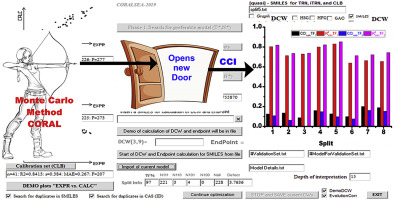当前位置:
X-MOL 学术
›
Chemometr. Intell. Lab. Systems
›
论文详情
Our official English website, www.x-mol.net, welcomes your
feedback! (Note: you will need to create a separate account there.)
CORAL: QSAR models of CB1 cannabinoid receptor inhibitors based on local and global SMILES attributes with the index of ideality of correlation and the correlation contradiction index
Chemometrics and Intelligent Laboratory Systems ( IF 3.7 ) Pub Date : 2020-05-01 , DOI: 10.1016/j.chemolab.2020.103982 Parvin Kumar , Ashwani Kumar
Chemometrics and Intelligent Laboratory Systems ( IF 3.7 ) Pub Date : 2020-05-01 , DOI: 10.1016/j.chemolab.2020.103982 Parvin Kumar , Ashwani Kumar

|
Abstract Obesity has acquired notable attention due to its high occurrence and link with grievous health problems such as hypertension, diabetes and heart disease. It has been reported that the endocannabinoid system executes a pivotal part in the management of food absorption, fat augmentation, and energy balance. In the present manuscript, we report a detailed QSAR analysis for 165 CB1 cannabinoid receptor inhibitors employing the Monte Carlo optimization process incorporated within the CORAL software. Eight splits are made from the whole dataset and sixteen QSAR models are developed from these splits employing two target function TF1 (without index of ideality of correlation) and TF2 (with index of ideality of correlation). All the QSAR models developed with TF2 have better predictive potential than the models developed with TF1. The model built for split 5 using TF2 is the leading model due to the higher value of the determination coefficient of the validation set ( R V a l i d 2 = 0.8518). The index of ideality of correlation (IIC) improves the statistical performance of CORAL-based QSAR-models and gives statistically robust predictive models of the investigated endpoint pIC50. In the present manuscript, a novel criterion “Correlation Contradiction Index (CCI)” is also applied to know its predictive potential. The absolute value of CCI for calibration set is less when QSAR models are developed employing IIC. The promoters of increase and decrease endpoint pIC50 are identified and these are applied to design seven new compounds. All the newly designed molecule were docked into in the active site of human cannabinoid receptor CB1 (PDB ID: 5tgz ).
中文翻译:

CORAL:基于局部和全局 SMILES 属性的 CB1 大麻素受体抑制剂的 QSAR 模型,具有相关理想指数和相关矛盾指数
摘要 肥胖症由于其发生率高且与高血压、糖尿病和心脏病等严重健康问题有关,因此受到了广泛关注。据报道,内源性大麻素系统在食物吸收、脂肪增加和能量平衡的管理中起着关键作用。在本手稿中,我们报告了对 165 种 CB1 大麻素受体抑制剂的详细 QSAR 分析,这些抑制剂采用了 CORAL 软件中的蒙特卡罗优化过程。从整个数据集进行八个分割,并从这些分割中开发出 16 个 QSAR 模型,使用两个目标函数 TF1(无相关理想指数)和 TF2(具有相关理想指数)。所有使用 TF2 开发的 QSAR 模型都比使用 TF1 开发的模型具有更好的预测潜力。由于验证集的决定系数值较高(RV alid 2 = 0.8518),使用 TF2 为 split 5 构建的模型是领先模型。相关性理想指数 (IIC) 提高了基于 CORAL 的 QSAR 模型的统计性能,并为研究的终点 pIC50 提供了统计上稳健的预测模型。在本手稿中,还应用了一个新的标准“相关矛盾指数(CCI)”来了解其预测潜力。采用 IIC 开发 QSAR 模型时,校准集的 CCI 绝对值较小。确定了增加和减少终点 pIC50 的启动子,并将这些启动子用于设计七种新化合物。所有新设计的分子都停靠在人大麻素受体 CB1(PDB ID:5tgz)的活性位点。
更新日期:2020-05-01
中文翻译:

CORAL:基于局部和全局 SMILES 属性的 CB1 大麻素受体抑制剂的 QSAR 模型,具有相关理想指数和相关矛盾指数
摘要 肥胖症由于其发生率高且与高血压、糖尿病和心脏病等严重健康问题有关,因此受到了广泛关注。据报道,内源性大麻素系统在食物吸收、脂肪增加和能量平衡的管理中起着关键作用。在本手稿中,我们报告了对 165 种 CB1 大麻素受体抑制剂的详细 QSAR 分析,这些抑制剂采用了 CORAL 软件中的蒙特卡罗优化过程。从整个数据集进行八个分割,并从这些分割中开发出 16 个 QSAR 模型,使用两个目标函数 TF1(无相关理想指数)和 TF2(具有相关理想指数)。所有使用 TF2 开发的 QSAR 模型都比使用 TF1 开发的模型具有更好的预测潜力。由于验证集的决定系数值较高(RV alid 2 = 0.8518),使用 TF2 为 split 5 构建的模型是领先模型。相关性理想指数 (IIC) 提高了基于 CORAL 的 QSAR 模型的统计性能,并为研究的终点 pIC50 提供了统计上稳健的预测模型。在本手稿中,还应用了一个新的标准“相关矛盾指数(CCI)”来了解其预测潜力。采用 IIC 开发 QSAR 模型时,校准集的 CCI 绝对值较小。确定了增加和减少终点 pIC50 的启动子,并将这些启动子用于设计七种新化合物。所有新设计的分子都停靠在人大麻素受体 CB1(PDB ID:5tgz)的活性位点。











































 京公网安备 11010802027423号
京公网安备 11010802027423号